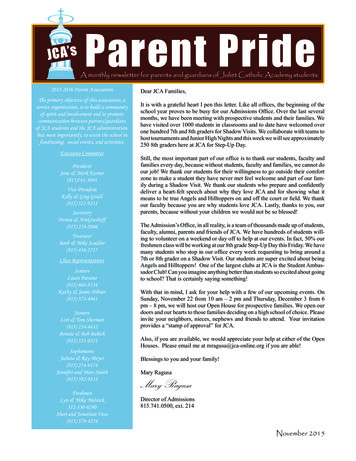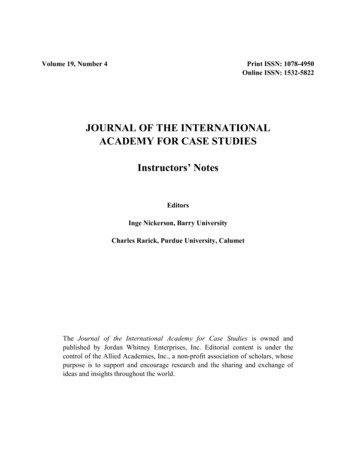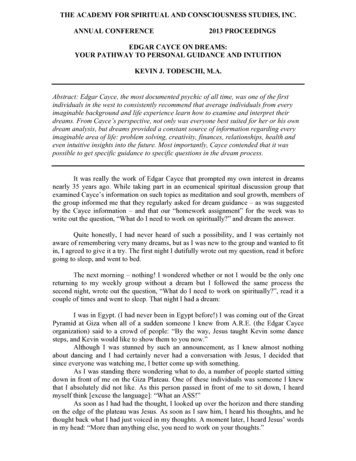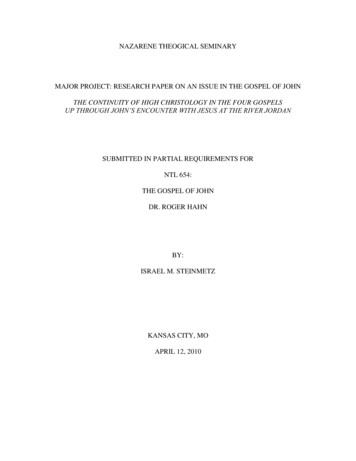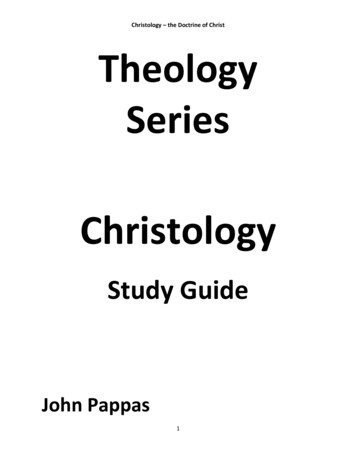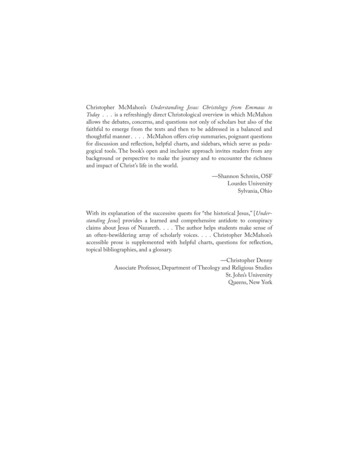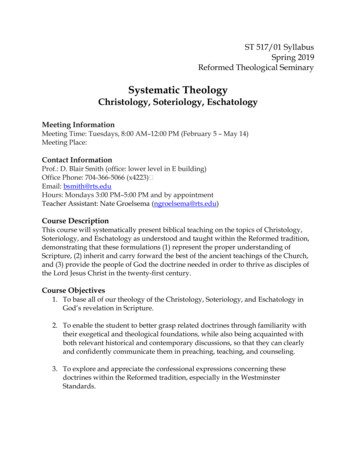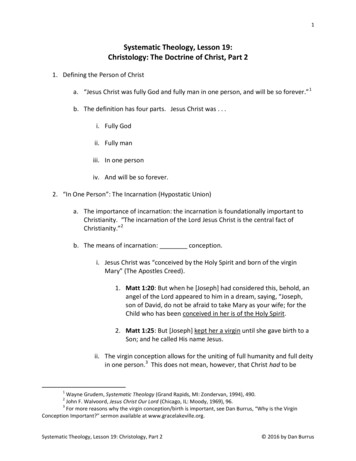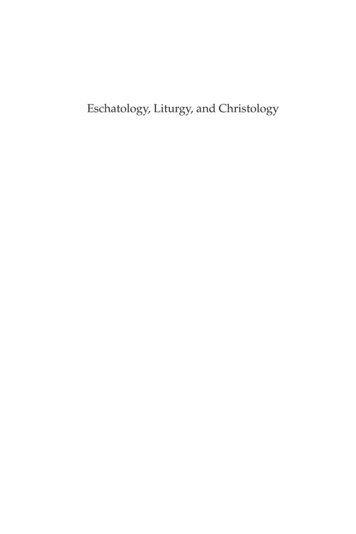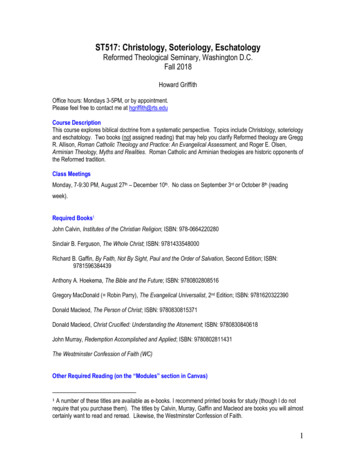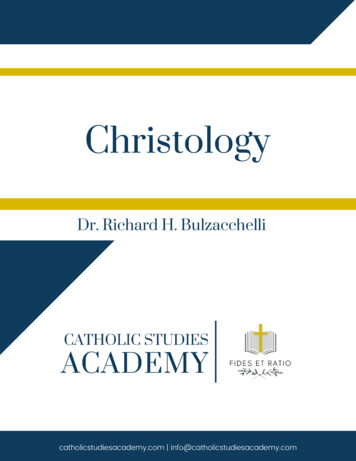
Transcription
ChristologyDr. Richard H. Bulzacchellicatholicstudiesacademy.com info@catholicstudiesacademy.com
ChristologySyllabus & ObjectivesThis course is designed to advance the students’ understanding of the theologicalproblems surrounding the Person and place of Jesus Christ in theology. Students will beexpected to engage in theological exploration of these problems surrounding the humanand historical reality of Jesus of Nazareth in relation to the claims the Church makessurrounding his divinity, his place in salvation, and his significance for the final outcomeof God’s act of creation. As we explore these questions through an examination of manyof the significant figures and events of the history of the Church, students will gain adeeper appreciation of the difficulties of the Christological problem, and the reasons thatthe Church says what she does, about Christ, and rejects as heresy what she does.Students who complete this course will be equipped to:Identify the major lines of expectation in the Old Testament and how thoseexpectations are tied together and fulfilled in the New Testament portrait of Jesus ofNazareth;Identify and define major Christological heresies, explaining why they are heresies;Relate the Jesus of history with the Jesus of faith in a coherent and orthodox way,according to the mind of the Catholic Church;Name the major Christological Councils of the Church in the Patristic Period, andexplain what Christological issues were at stake in them;Identify the major creedal statements associated with the Councils of Nicaea I,Constantinople I, Ephesus, and Chalcedon, and what particular elements each addedto our understanding and articulation of the dogma of Christ.catholicstudiesacademy.com info@catholicstudiesacademy.com
ChristologyLecturesThe following lectures will be provided in this course:What is Christology, and what is at stake in it for orthodoxChristianity?Messianism in the Old TestamentThe New Testament Synthesis: Weaving the threads of expectation,reimagining the MessiahThe New Testament Synthesis: Law and Grace: Christ as Prophet likeMoses, Righteous One / Man of the Torah, High Priest, and PerfectVictimHigh Christological creedal assertions in the Johannine and Paulinetexts: Christ as Logos, New Adam, Alpha and Omega, Eschatos AdamFrom the Apostolic Fathers to the cusp of the Arian controversy: theparadox of the God-Man unityThe Arian HeresyThe First Council of Nicaea (325)Apollinaris of Laodicea vs. Theodore of Mopsuestia and the FirstCouncil of Constantinople (381)Antioch vs. Alexandria: The Councils of Ephesus (431) and Chalcedon(451)The Third Council of Constantinople (681) and the controversies overMonothelitism and the two operations in Christ.Other controversies and concluding commentscatholicstudiesacademy.com info@catholicstudiesacademy.com
Introduction to ChristologyIs it possible to have a Jewish Christology or is Christology only a Christian concern?What does the term “Christ” (Χριστός Christos) or “Messiah” ( ַ מָ ׁ ִשיח Mashiach) mean?In the Old Testament, we can locate numerous prophetic expectations that are notidentical to specifically messianic expectations. What happens, in the New Testament, tothe concept of “Messiah” or “Christ” in relation to these other expectations?What is the difference between the way in which the term “Emmanuel” ( עִ ּ ָמנו ּאֵ ל Immanuel[God-with-us]) is understood in the Old Testament vs. the New Testament?How is Christology bound-up with other major theological subdisciplines, like Trinitariantheology, soteriology, eschatology, ecclesiology, and sacramental theology?catholicstudiesacademy.com info@catholicstudiesacademy.com
Introduction to ChristologyNotes:catholicstudiesacademy.com info@catholicstudiesacademy.com
Messianism in the Old TestamentSuggested readings: Raymond E. Brown, S.S., An Introduction to New TestamentChristology (New York: Paulist Press, 1994), 155–161.In the Old Testament, is the term “Messiah” necessarily reserved for one, definitive figure?To whom does the term “Messiah” refer in the 10th century B.C. in the Old Testamentwritings?To whom does the tern “Messiah” refer from around the 8th century B.C. in the OldTestament? Is this necessarily one person, or is it possible that it referred to a class ofpersons?According to Old Testament expectations, is “Messiah” necessarily the cause of God’spresence among his people or is “Messiah” a sign of that presence?catholicstudiesacademy.com info@catholicstudiesacademy.com
Messianism in the Old TestamentNotes:catholicstudiesacademy.com info@catholicstudiesacademy.com
The New Testament Synthesis,Part 1Suggested readings: Raymond E. Brown, S.S., An Introduction to New TestamentChristology (New York: Paulist Press, 1994), 71–100; Matthew 1:1–2:12.What is the meaning of the “New David” or “Son of David”? This is the most obvious anddirect Messianic attribution of Jesus in the New Testament. How does it relate to the ideaof Jesus as “Son of God” in the original sense of that expression?How does the Genealogy in Matthew’s Gospel address the idea of Jesus as the “NewDavid?” What significance is this title given in Matthew’s gospel? Is it purely political orhas it taken on a fully historical or even cosmological significance?How does this title move beyond the idea of a king for Israel and come to be bound up withthe King of the Universe?The concept “Son of God” comes to be associated in Christianity with the idea of theIncarnation. Distinguish between the classifications, “high Christology” and “lowChristology.” What evidence can we find in the New Testament of a high Christology?The concept of Davidic kingship is associated with the concepts of “Son of Man” and“Suffering Servant” in the New Testament as well. How do these associations affect theconcept of “Messiah”?What does it mean to say that Jesus is “Judge” in the New Testament portrait of Jesus?catholicstudiesacademy.com info@catholicstudiesacademy.com
The New Testament Synthesis,Part 1Suggested readings: Raymond E. Brown, S.S., An Introduction to New TestamentChristology (New York: Paulist Press, 1994), 71–100; Matthew 1:1–2:12.What does it mean to say that Jesus is High Priest and Victim?What is the meaning of the figure of the “Son of Man” in the Old Testament? Where do wesee this term used explicitly in the Old Testament? How was this term used in commonlanguage in the time of Christ? How does it relate to the idea of the Perfect High Priest?How does the New Testament portrait of Jesus of Nazareth fulfill these expectations?Who is the “Suffering Servant”? How is this concept related to, and also distinct from, thatof the “Son of Man”? How does the New Testament portrait of Jesus of Nazareth fulfill thisexpectation?Consider other Old Testament figures who became typological expectations: Abel, Jonah,Joshua, Melchizedek? What did figures like these represent to the Hebrew People, andhow does the New Testament portrait of Jesus of Nazareth in the New Testament addressthese expectations? Can you think of other figures that have typological significanceassociated with the New Testament portrait of Jesus of Nazareth?What is the Christologicalsignificance of the periscope in the Gospel of Matthew (16:13–19), where Peter makes hisconfession about Jesus?catholicstudiesacademy.com info@catholicstudiesacademy.com
The New Testament Synthesis,Part 1Notes:catholicstudiesacademy.com info@catholicstudiesacademy.com
The New Testament Synthesis,Part 2Suggested readings: Raymond E. Brown, S.S., An Introduction to New TestamentChristology (New York: Paulist Press, 1994), 105–141; Matthew 2:13–7:29; John 4:4–42.What is the meaning of the expectation of the “New Moses” or “Prophet like Moses”? Canyou think of passages in the New Testament that witness to Christ as this figure?What is the meaning of the expectation of the “Righteous One” or “Man of the Torah”? Howdoes the high Christology of the New Testament depict Jesus of Nazareth as the perfectfulfillment of this expectation?How is does the idea of sacrifice in Hebrew thought lead to an ideal identity between priestand offering? How is this idea related to the New Testament portrait of Jesus of Nazarethand the theology of atonement presented there?Consider how each of the concepts presented in this letter actually belong together as awhole in the thought of the New Testament authors.catholicstudiesacademy.com info@catholicstudiesacademy.com
The New Testament Synthesis,Part 2Notes:catholicstudiesacademy.com info@catholicstudiesacademy.com
High Christological Creedal Assertionsin the Johannine and Pauline TextsSuggested readings: John 1:1–14; 1 Corinthians 15:35–58; Ephesians 2:11–22; Philippians 2:5–11; Colossians 1:15–20; 4:1–16; Hebrews 1:1–4.Logos (λόγος) Christology is most obvious in the Gospel of John, where it is explicitlypresented in the Prologue’s Creedal Hymn. What can you say about the Logos based onthis text? Can you see the orthodox Faith there? Can you also see where there may beambiguities that would lead to later controversies?What does the concept of the New Adam entail in the Johannine and Pauline writings?How does it relate to a Eucharistic ecclesiology based upon the idea of true, bodilyCommunion?What is meant by the idea of Christ as the Alpha and Omega? Consider both the divineaspect of Christ and the aspect of Christ as the New Adam.What does Paul mean when he speaks of Christ as eschatos Adam (ἔσχατος Ἀδάμ) andandra teleion (ἄνδρα τέλειον)? How does this understanding of Christ relate to the idea ofChrist as New Adam and Alpha and Omega?catholicstudiesacademy.com info@catholicstudiesacademy.com
High Christological Creedal Assertionsin the Johannine and Pauline TextsNotes:catholicstudiesacademy.com info@catholicstudiesacademy.com
From the Apostolic Fathers to theCusp of the Arian ControversySuggested readings: Richard A. Norris, Jr., trans., ed., The Christological Controversy,Sources of Early Christian Thought, (Philadelphia: Fortress Press, 1980), 1–17, 33–81.What is Gnosticism and how does it relate to the Christological heresies we find addressedby the Fathers in the primitive Church?Why does St. Ignatius of Antioch’s view of Church and Eucharist as the means of salvationrequire a God-Man Christology?St. Justin Martyr approaches Christianity through the Logos Christology of John. How doeshe describe the Logos and what is the theological shortcoming of this description?Marcion of Sinope is an early Docetist. Why does Docetism reject the belief in a literalIncarnation of God? Do they deny that Jesus is God? What do they think he is?catholicstudiesacademy.com info@catholicstudiesacademy.com
From the Apostolic Fathers to theCusp of the Arian ControversyMelito of Sardis argues typologically from the Scriptures that the images presented in theOld Testament are but shadows of greater and more perfect realities fulfilled in Christ.This approach is widely represented in the Fathers, but is also seen in the New Testament,especially in Hebrews. How does this line of reasoning point in the direction of a highChristology? Consider our earlier lectures in which we discussed Old Testamentexpectations, in particular, those of the New David, the New Moses, the Man of the Torah,and Emmanuel.What is the basis of Irenaeus of Lyons’s argument against the Marcionites? Do yourecognize this theme from Fundament Theology and Introduction to Moral Theology?How does Tertullian of Carthage advance the theological state of the question about Christin his own day? How is his language a step in the right direction but not yet precise enoughto constitute the formulation that will come later?Origen of Alexandria continues in the line of Logos Christology as we saw in Justin Martyr.How does he attempt to explain the Incarnation? What are the shortcomings of hisapproach?What is the major heresy Paul of Samosata attempts to address? Why does that heresyarise? What heresy does Paul resuscitate for his own part while attempting to confront it?catholicstudiesacademy.com info@catholicstudiesacademy.com
From the Apostolic Fathers to theCusp of the Arian ControversyNotes:catholicstudiesacademy.com info@catholicstudiesacademy.com
The Arian HeresySuggested readings: Arius, Letter to Alexander of Alexandria. available onlineArius believes in an Incarnation, and in this way is not a Docetist. But his view of theIncarnation shares a common theme with Docetism in that there remains an underlyingGnostic prejudice regarding the way he thinks of matter in relation to God. Can you explainthis?What does Arius think the Logos is?In Arius’ own articulation of his Christological position, he quotes passages from Scripturewhich seem, on his reading, to support his view that the Logos is not God in the way that theFather is God. Can you see why he reads these passages the way he does?Can you think of any people in the broader Christian tradition today who hold views aboutthe Logos similar to those held by Arius?catholicstudiesacademy.com info@catholicstudiesacademy.com
The Arian HeresyNotes:catholicstudiesacademy.com info@catholicstudiesacademy.com
The First Council of Nicaea (325)Suggested readings: Richard A. Norris, Jr., trans., ed., The Christological Controversy,Sources of Early Christian Thought, (Philadelphia: Fortress Press, 1980), 83–101; Creed ofNicaea.Arius and the Eusebius had argued along Gnostic lines, that the Logos was a demiurge, notGod in the way that the Father is God, because the material world, which the Logos fashions,could not bear the direct touch of God. What was the shortcoming of this view, forAthanasius? How did it fail both on its own terms and on the terms of Christianity’s centraleschatological affirmation?At issue at the Council of Nicaea is the sense in which the Logos is divine. The Arian andAthanasian poles of this debate centered on an option between the words homoiousion(ὁμοιούσιον) and homoousion (ὁμοούσιον). The former was used by the Arians and thelatter was used by Athanasius. Athanasius’ view, and his language, prevailed at the Council.What was the difference in meaning between these two terms? Why was it so difficult toarrive at this definition? Consider the way in which metaphysical terminology in differentlinguistic contexts and within competing philosophical paradigms required the Church toarrive at and standardize her own definitions in the course of this and subsequent debates.catholicstudiesacademy.com info@catholicstudiesacademy.com
The First Council of Nicaea (325)The homoousion position of Athanasius and Nicaea is really about the divinity of theLogos. What phrases are introduced into the Creed of Nicaea to ensure that it wasunderstood that orthodox Christianity involved the belief that the Logos, who becameIncarnate, is and always has been God in the same sense as the Father is God?It is a very difficult thing to say that there is only one God, that the Father is not the Son, andthat both the Father and the Son are God in the same sense. Does the term homoousionfully communicate this idea or does it leave room for a new controversy? How do theFathers attempt to avoid a Sabellian interpretation in the Nicaean Creed?After the Council, many objected to the term homoousion because it was associated withSabellianism and was not actually found in the Scriptures. Attempts to avoid the term,however, failed, from the perspective of orthodoxy, though, because they could notpreclude an Arian interpretation. Such creedal formulations came to be called “SemiArian,” and their presence allowed actual Arians to argue that their own views wereorthodox under those formulations. Thinking ahead, what did this problem do to helpdistinguish between the way we regard the definitions of ecumenical councils and othermore regionalized synodal acts?catholicstudiesacademy.com info@catholicstudiesacademy.com
The First Council of Nicaea (325)Notes:catholicstudiesacademy.com info@catholicstudiesacademy.com
Apollinaris of Laodicea vs. Theodore of Mopsuestiaand the First Council of Constantinople (381)Suggested readings: Richard A. Norris, Jr., trans., ed., The Christological Controversy, Sources ofEarly Christian Thought, (Philadelphia: Fortress Press, 1980), 21–26, 103–122; The Creed ofConstantinople (Nicaeano-Constantinopolitan Creed) available online.Following Nicaea, the debate shifted from the sense in which the Logos was divine to the sense inwhich the Logos was Incarnate. The discussion came to concern Logos ensarkos (λόγος ἐνσαρκός).What does this phrase mean, and how is it a central issue in the controversies that move from thistime through the Council of Chalcedon?Apollinaris holds a view that can be described as “monopsychism” or “mononousism” dependinghow we define our Greek terms. What is the affirmation at the center of this view and why does hemake it?What does Apollinaris’ view positively achieve in the wake of the Arian controversy and the faith ofNicaea?Where does Apollinaris’ position fail in the eyes of his critics? Consider the idea we discussed inLesson 4 of the Righteous One and Man of the Torah. Does Apllinaris’ position preserve thisassertion about Jesus of Nazareth or undermine it?Theodore says that Christ has two natures, but it is unclear whether, for him, the two naturescoincide in a single individual person. Contrary to Apollinaris, Theodore insists that there really is ahuman spiritual soul in Christ, but that the union between humanity and divinity is effected throughthe communion of wills. How does Theodore’s view result in exactly the problem Apollinaris soughtto avoid? On Theodore’s model, is there any real agency proceeding from Christ under his humannature? What important metaphysical question about the composition of Christ remains onTheodore’s model?Consider how the Creed of the Council of Constantinople (the Creed normally professed in thecontext of the Eucharistic liturgy in the Latin Rite) attempts to preserve the essential content of theCreed of Nicaea while addressing the errors found in both Apollinaris and Theodore.catholicstudiesacademy.com info@catholicstudiesacademy.com
Apollinaris of Laodicea vs. Theodore of Mopsuestiaand the First Council of Constantinople (381)Notes:catholicstudiesacademy.com info@catholicstudiesacademy.com
Antioch vs. Alexandria: The Councilsof Ephesus and ChalcedonSuggested readings: Richard A. Norris, Jr., trans., ed., The Christological Controversy, Sources ofEarly Christian Thought, (Philadelphia: Fortress Press, 1980), 123–159.Common Christological Declaration between the Catholic Church and the Assyrian Church of theEast (11 November 1994): available online.Common Declaration of Pope Paul VI and of the Pope of Alexandria, Shenouda III (10 May 1973):available onlineWhy was the term Theotokos so problematic for the Antiochian school? Why did they find it anaffront to the Nicaean Creed?Beginning in the early twentieth century, Western scholars began to discover previouslymisappropriated texts and other texts previously unknown to them, which allowed a more accurateportrait of Nestorius’ actual Christological views to distinguish themselves from the heresy ofNestorianism condemned at the Council of Ephesus. It becomes clear that Nestorius’ views were inmany respects caricatured by his opponents, and that his central concern was a point that, largelydue to his own influence, became a central principle in Christology, which we call, the“communication of idioms.” What does this mean?Nestorius distinguishes a divine physis and a human physis in Christ, but he speaks ambiguously asregards the concept of person. The term prosopon is subject to a range of meanings, even by thetime of Nestorius (in fact, this term never made it into any of the creedal statements in the earlyecumenical councils), and at times can designate a juridical entity, like Microsoft Corporation, whileat other times it can mean a particular subject. So, Nestorius speaks of Christ as one person withtwo natures, but then at other times speaks of the human person of Jesus being assumed by thedivine person Logos. What heresies is Nestorius trying to avoid here? What valid points doesNestorius make? Where does his articulation ultimately fail? Is there warrant for thecharacterization of Nestorianism as the assertion that in the Christ, Jesus is one individual and theLogos is another, the two held together as a kind of legal fiction?Cyril of Alexandria begins by saying that Christ has but one nature, in reaction to Nestorius. Howdoes he attempt to avoid Apollinarism? What does he add to his definition that Apollinaris hadexplicitly denied?catholicstudiesacademy.com info@catholicstudiesacademy.com
Antioch vs. Alexandria: The Councilsof Ephesus and ChalcedonHow are Nestorius and Cyril after the same thing—the complete humanity of Jesus? What are theparticular merits of Cyril’s approach to this problem? What are its flaws?Cyril eventually accepts a new articulation—that Christ is one hypostasis in two natures (the Greekword for “nature” here is physis. Thus he accepts the Duophysism eventually articulated by Leoand Chalcedon and rejects his former Monophysism. What do these two terms mean, respectively?After the Council of Ephesus, the so-called Formula of Union clarifies many of the points ofNestorius and Cyril had each attempted to make in their own language, while avoiding the problemsin their original articulations. How did this formula express the idea that the Logos could actuallybe born of the Virgin Mary without being generated by her ontologically, as to the divine nature,according to which he exists eternally as person? Explain how this insight comes to expressed inthe odd-seeming formulation that Christ is a Person who is human but not a human person.Euteches retained a strong Monophysite view following the Council of Ephesus, as a reactionagainst Nestorianism, which had been formally condemned. Why does this view fail? Rememberthat the full divinity and the full humanity of Christ are essential for Christianity to fulfill itsfundamental eschatological goal. Can Monophysism pass this test?How does the Creed of the Council of Chalcedon resolve the tension and avoid both Monophysismand Nestorianism?What does the term hypostatic union mean?Nestorius is venerated as a saint in the Assyrian Church of the East, but this Church does notprofess the Nestorian heresy. Do you think that the Common Declaration of faith singed by PopeSt. John Paul II and Katholikos Mar Dinka IV lays to rest the Christological controversy in such away that, had it been presented at Ephesus, schism would have been avoided?The Coptic Orthodox Church still identifies as Monophysitic, but in 1973, Pope Paul VI and PopeShenouda III signed a Joint Declaration in which they explicitly agreed to a particular Christologicalarticulation both found satisfactory. Do you think this formulation would have avoided schism atthe Council of Chalcedon?catholicstudiesacademy.com info@catholicstudiesacademy.com
Antioch vs. Alexandria: The Councilsof Ephesus and ChalcedonNotes:catholicstudiesacademy.com info@catholicstudiesacademy.com
The Third Council ofConstantinople (681)Suggested readings: Definition of Faith of the Third Council of Constantinople (681):available online.What does the term Monotheletism mean? How is it related to earlier controversies, likeApollinarism?At first glance, Monotheletism seems a reasonable and pious Christological thesis. Howdoes the view appear to coincide with the view of Christ as the fulfillment of theexpectation of the Man of the Torah in the New Testament?Why, in fact, does Monotheletism fail this test? Consider again the problems withApollinarism and why that view failed. What about the view of Theodore of Mopsuestia?What are the similarities and differences between that view and Monotheletism?What is meant by “the two operations in Christ?”If Christ is fully human, with every power of operation proper to human beings, and alsofully God, with every power of operation proper to God, what can we say concerningChrist’s knowledge? Consider that in the New Testament, there are passages in whichChrist appears to be ignorant of temporal events. Can Christ both know and not know thesame truths at the same time? Would that be a contradiction, or is there more to thisproblem?Does Christ possess the theological virtues of faith, hope, and love, or only love? Explain.catholicstudiesacademy.com info@catholicstudiesacademy.com
The Third Council ofConstantinople (681)Notes:catholicstudiesacademy.com info@catholicstudiesacademy.com
Other Controversies andConcluding CommentsSimilar in nature to earlier heresies, like Nestrianism, Adoptionism arose as a major and recurringproblem in the late Patristic period or early Middle Ages, around the time of the Second Council ofNicaea (787). What were the Adoptionists really trying to say? How was their basic point anattempt to affirm the Chalcdeonian faith? Why did they fail in this attempt?Peter Abelard said that “Christ as a human being is nothing.” This affirmation, which was formallycondemned as heretical, sounds Docetistic on the one hand, or Adoptionistic on the other. How?What do you think Abelard might have been trying to say?St. Anselm of Canterbury poses the question “Why did God become a human being?” Ratzingerargues that, in doing so, Anselm inadvertently introduced a new question—not how but why—andthus obscured what had before been the obvious link between Christology and Eschatology, as wellas other theological disciplines such as Soteriology and Ecclesiology. He argues that this separationof Christology as its own problem leads to an unanswerable conundrum concerning the reason forthe Incarnation and purpose of creation. Can you explain Ratzinger’s perspective on this point?Hans Urs von Balthasar proposed that, in his descent into hell, Christ assumed the full weight of thepenalty due to human sin: that in descending into hell, he descended into damnation. Why didBalthasar offer this proposal? What did he think it achieved? Why, finally, could it not be acceptedas orthodox?In the twentieth century, the Jesus Seminar sought to subject the question of orthodoxy toacademic scrutiny, in a climate in which the academy had largely taken on a secular, scientisticmentality. What was the result of this move? What positive contributions emerged from this workand what deeply negative influences did it have on Christian culture?In the 1960’s the “Jesus Movement” involved an existentialist approach to the Christian question.Rather than definite ontological assertions about Christ, it proposed that Christ represents afundamental challenge, and that before this challenge, each person had to take a stand. Out of thismovement emerged such theatrical productions as “Godspell” and “Jesus Christ, Superstar.” Inmany ways, this movement involved an attempt to recover the historical humanity of Jesus, onaccount of which divine attribution represents such a significant theological difficulty, as it was inthe time of Christ’s earthy ministry. What broader influences, both good and bad, did this approachto the problem of Christ have on Christian culture in our time? Between this movement and theJesus Seminar, can you see how Christianity can be distorted and subsumed under secular, politicalagendas? Can an existential approach to the problem of Christ have its place in orthodoxChristianity, though?catholicstudiesacademy.com info@catholicstudiesacademy.com
Christology catholicstudiesacademy.com info@catholicstudiesacademy.com Syllabus & Objectives I d e n t i f y t h e m a jor lines of ex p ectat i on in t h e O ld T es ta m en t and how those e x p ec t a t i o n s are ti ed toge th er a n d fulfi lled in t he N ew T es ta m en t portrait of Jesus of N a z a r e t h ;
